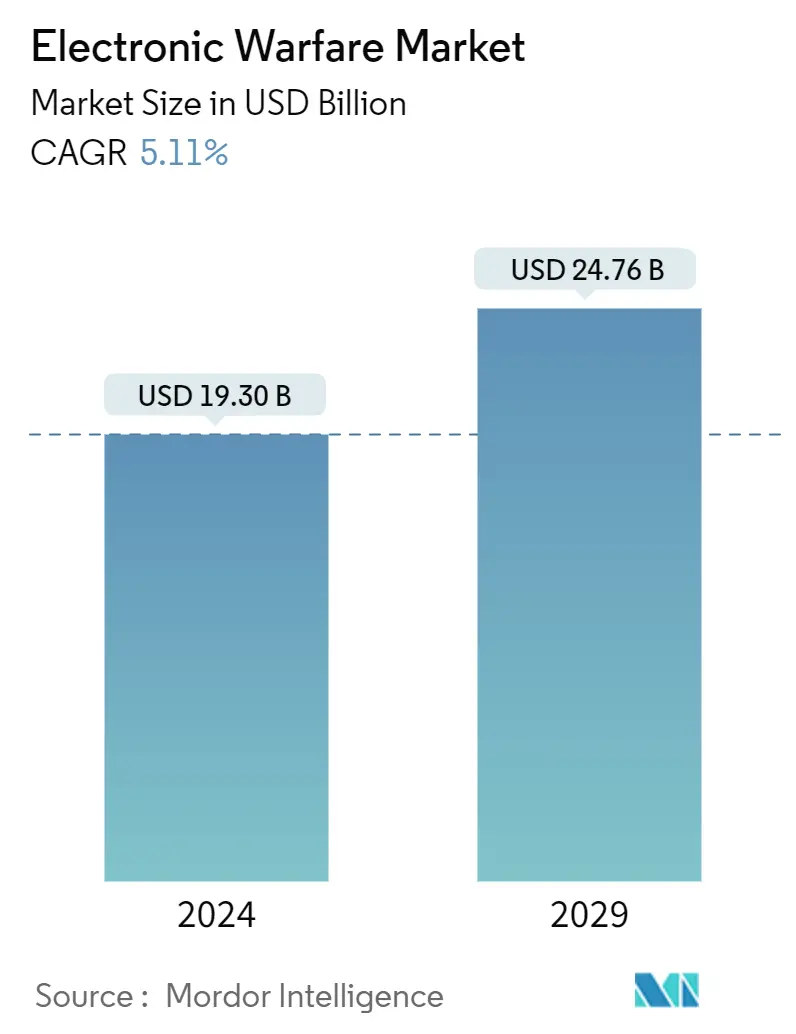Market Size of Electronic Warfare Industry

| Study Period | 2019 - 2029 |
| Market Size (2024) | USD 19.30 Billion |
| Market Size (2029) | USD 24.76 Billion |
| CAGR (2024 - 2029) | 5.11 % |
| Fastest Growing Market | North America |
| Largest Market | Asia Pacific |
| Market Concentration | Medium |
Major Players
*Disclaimer: Major Players sorted in no particular order |
Electronic Warfare Market Analysis
The Electronic Warfare Market size is estimated at USD 19.30 billion in 2024, and is expected to reach USD 24.76 billion by 2029, growing at a CAGR of 5.11% during the forecast period (2024-2029).
The ongoing border disputes between several nations as well as the changing nature of modern warfare are expected to generate substantial demand for sophisticated electronic warfare systems that possess advanced capabilities thereby generating significant market growth during the forecast period. Moreover, the development of multilayered defensive systems owing to significant technological developments as well as the growing integration of electronics into military hardware is expected to bolster the growth of the market in the coming years.
On the other hand, growth in complexities concerning the integration of electromagnetic systems will detriment market growth.
Significant progress in terms of the development of cognitive electronic warfare which refers to the integration of advanced technologies such as artificial intelligence (AI) and neural networks to manufacture faster systems with minimal lag in threat detection and tracking will alter the current market dynamics, drive innovation from the market players and create potential business opportunities during the forecast period.
Electronic Warfare Industry Segmentation
Electronic Warfare involves the use of electromagnetic spectrum signals such as radio, infrared, or radar to attack or impede enemy operations. Moreover, electronic warfare can help to disrupt, deny, and degrade the ability of the enemy forces to make use of such electromagnetic signals.
The electronic warfare market is segmented by capability, platform, and geography. By capability, the market is segmented into electronic attack, electronic protection, and electronic support. By platform, the market is segmented into air, sea, land, and space. The report also covers the market sizes and forecasts for the electronic warfare market in major countries across different regions. For each segment, the market size is provided in terms of value (USD).
| Capability | |
| Electronic Attack | |
| Electronic Protection | |
| Electronic Support |
| Platform | |
| Air | |
| Sea | |
| Land | |
| Space |
| Geography | |||||||
| |||||||
| |||||||
| |||||||
| |||||||
|
Electronic Warfare Market Size Summary
The electronic warfare market is poised for significant growth, driven by the increasing complexities of modern warfare and the ongoing border disputes among nations. This demand is further fueled by advancements in multilayered defensive systems and the integration of electronics into military hardware. The market is expected to expand as countries invest in sophisticated electronic warfare systems with advanced capabilities. The development of cognitive electronic warfare, which incorporates artificial intelligence and neural networks, is set to transform market dynamics, fostering innovation and creating new business opportunities. Global military expenditure has led to the retrofitting of naval vessels with next-generation electromagnetic solutions, enhancing their defensive capabilities against threats such as anti-ship missiles.
The market landscape is characterized by a fragmented competitive environment with both global and local players vying for market share through technological advancements and product offerings. Major companies like Lockheed Martin, L3Harris Technologies, Northrop Grumman, RTX Corporation, and Leonardo S.p.A. are at the forefront, investing heavily in research and development to create advanced warfare products. Collaborations with defense forces worldwide are common as companies strive to meet military requirements and expand their technological capabilities. The presence of international companies with substantial investments in new technologies is expected to increase their market share, further intensifying competition in the electronic warfare sector.
Electronic Warfare Market Size - Table of Contents
-
1. MARKET DYNAMICS
-
1.1 Market Overview
-
1.2 Market Drivers
-
1.3 Market Restraints
-
1.4 Porter's Five Forces Analysis
-
1.4.1 Bargaining Power of Buyers/Consumers
-
1.4.2 Bargaining Power of Suppliers
-
1.4.3 Threat of New Entrants
-
1.4.4 Threat of Substitute Products
-
1.4.5 Intensity of Competitive Rivalry
-
-
-
2. MARKET SEGMENTATION
-
2.1 Capability
-
2.1.1 Electronic Attack
-
2.1.2 Electronic Protection
-
2.1.3 Electronic Support
-
-
2.2 Platform
-
2.2.1 Air
-
2.2.2 Sea
-
2.2.3 Land
-
2.2.4 Space
-
-
2.3 Geography
-
2.3.1 North America
-
2.3.1.1 United States
-
2.3.1.2 Canda
-
-
2.3.2 Europe
-
2.3.2.1 United Kingdom
-
2.3.2.2 Germany
-
2.3.2.3 France
-
2.3.2.4 Russia
-
2.3.2.5 Rest of Europe
-
-
2.3.3 Asia-Pacific
-
2.3.3.1 China
-
2.3.3.2 India
-
2.3.3.3 Japan
-
2.3.3.4 South Korea
-
2.3.3.5 Rest of Asia-Pacific
-
-
2.3.4 Latin America
-
2.3.4.1 Brazil
-
2.3.4.2 Mexico
-
2.3.4.3 Rest of Latin America
-
-
2.3.5 Middle East and Africa
-
2.3.5.1 Saudi Arabia
-
2.3.5.2 United Arab Emirates
-
2.3.5.3 Rest of Middle-East and Africa
-
-
-
Electronic Warfare Market Size FAQs
How big is the Electronic Warfare Market?
The Electronic Warfare Market size is expected to reach USD 19.30 billion in 2024 and grow at a CAGR of 5.11% to reach USD 24.76 billion by 2029.
What is the current Electronic Warfare Market size?
In 2024, the Electronic Warfare Market size is expected to reach USD 19.30 billion.

